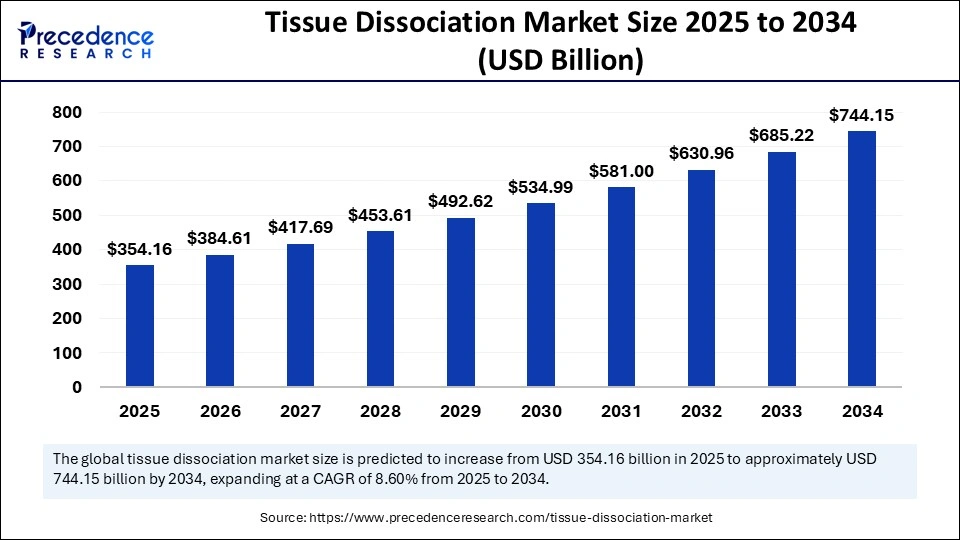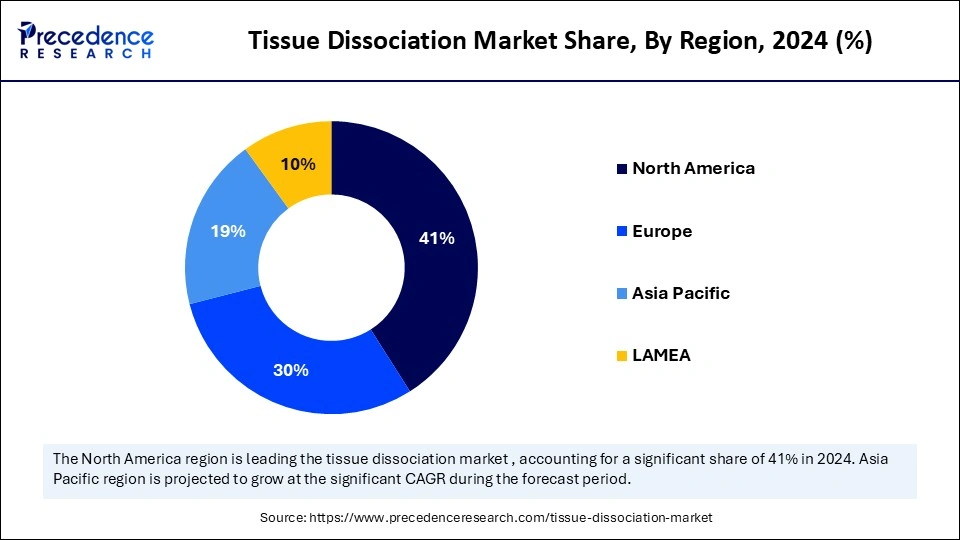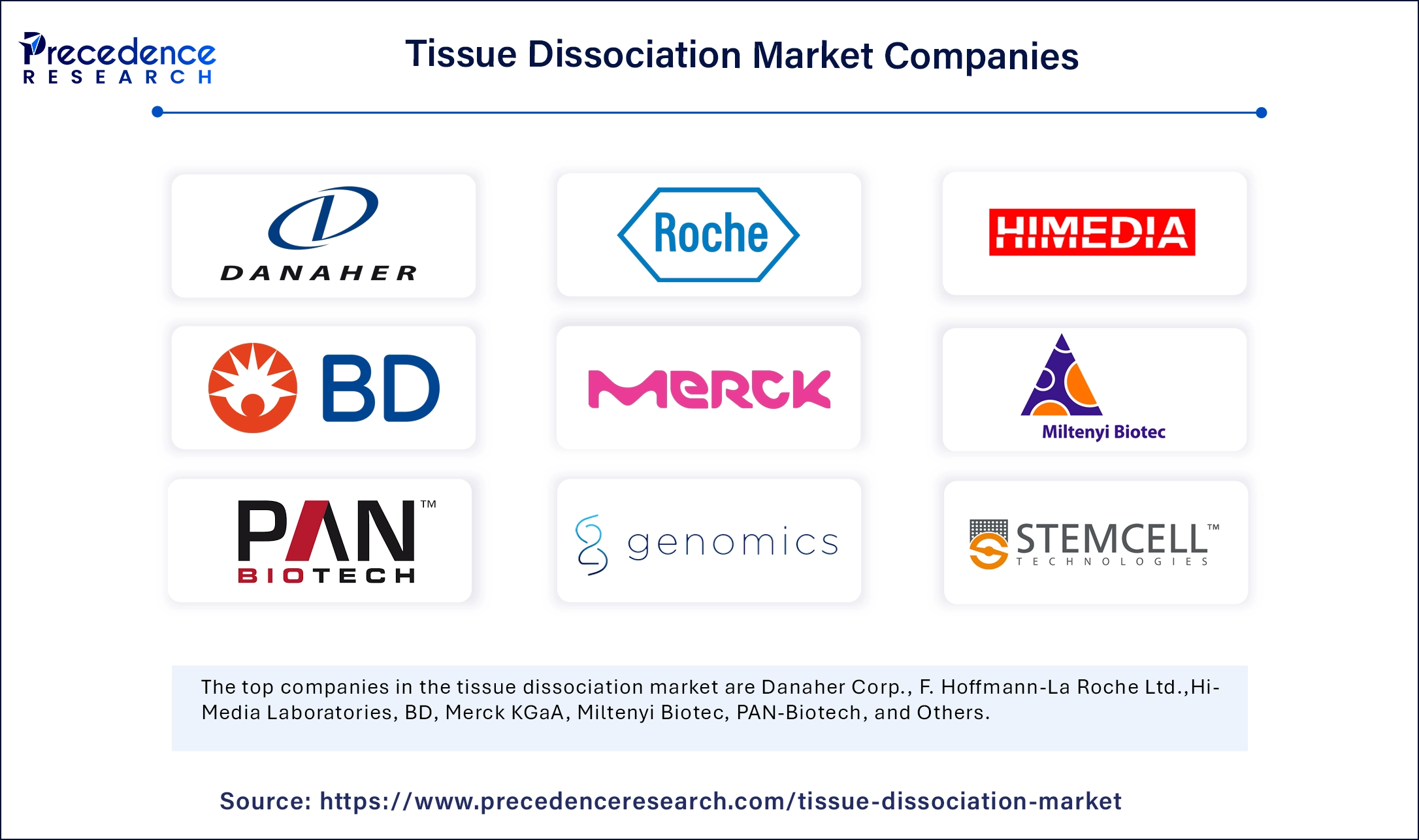The global tissue dissociation market size accounted for USD 354.16 million in 2025 and is forecasted to hit around USD 744.15 million by 2034, representing a CAGR of 8.60% from 2025 to 2034. The market sizing and forecasts are revenue-based (USD Million/Billion), with 2024 as the base year.
The global tissue dissociation market size was calculated at USD 326.11 million in 2024 and is predicted to increase from USD 354.16 million in 2025 to approximately USD 744.15 million by 2034, expanding at a CAGR of 8.60% from 2025 to 2034. The growth of the market is driven by the increasing government funding for cell-based research. The rising demand for personalized treatments further supports market expansion.

The integration of Artificial Intelligence revolutionizes the tissue dissociation process by enhancing efficiency and precision. AI algorithms make a multi-view model of the cell for both predictive and dynamic analysis. AI technology enables detailed analysis of massive data and provides insights into how dissociated cells work. AI also accelerates cell-based research. It analyzes tissue characteristics and dissociation parameters, leading to more efficient dissociation.
The tissue dissociation market is growing rapidly due to the rising cell-based research. Tissue dissociation is a significant step in the beginning of a broad range of research applications. Tissue dissociation is crucial in vaccines and cancer treatment research. The main goal of tissue dissociation is to collect as many viable cells as possible without negatively affecting cell function or viability. This procedure is required to eliminate the scaffolding and structural support of tissues that are significant for cell viability and major downstream applications. Tissue dissociation systems are vital tools to simplify individual cell analysis in drug development, disease research, and cell biology studies. The rising focus on novel drug discovery and development further contributes to market growth, as tissue dissociation plays a crucial role in drug screening.
| Report Coverage | Details |
| Market Size by 2034 | USD 744.15 Million |
| Market Size in 2025 | USD 354.16 Million |
| Market Size in 2024 | USD 326.11 Million |
| Market Growth Rate from 2025 to 2034 | CAGR of 8.60% |
| Dominated Region | North America |
| Fastest Growing Market | Asia Pacific |
| Base Year | 2024 |
| Forecast Period | 2025 to 2034 |
| Segments Covered | Tissue Type, Product Type, Source, Technology Type, Application, End User, and Regions |
| Regions Covered | North America, Europe, Asia-Pacific, Latin America and Middle East & Africa |
Rising Demand for Cell-Based Therapy
The increasing demand for cell-based therapies is a key factor driving the growth of the tissue dissociation market. Cell therapies involve the use of viable cells to target and treat specific conditions by replacing damaged cells. These therapies require isolating and preparing cells, in which tissue dissociation plays a key role. There is a rising usage of human embryonic stem cells in regenerative medicine. These highly potent stem cells, derived from early-stage human embryos, are vital to modern biomedical research due to their ability to differentiate into various cell types. Their therapeutic potential spans a wide range of conditions, including cancer, neurodegenerative issues, CVDs, spinal cord injury, tissue damage, and diabetes. In addition, the rising use of cells in drug discovery and development drives market growth.
Technical Challenges
The tissue dissociation market growth is limited due to several challenges, such as achieving constant and reproducible tissue dissociation is very complicated, particularly while working with various tissue types or patient samples. Differences in tissue characteristics, like cell-cell adhesion properties, composition of extracellular matrix, and density of tissue, affect the efficiency of tissue dissociation. Moreover, tissue dissociation techniques require specialized equipment and reagents, which can be expensive.
Adoption of TissueGrinder Technology
The adoption of TissueGrinder technology is increasing, creating immense opportunities in the tissue dissociation market. This technology enables the efficient isolation of single cells from biological tissues by mechanical dissociation. This minimizes mechanical stress, preserving the physiological characteristics of the cells and ensuring that diagnostics performed on them yield more accurate and reliable results. By utilizing a combination of shearing and cutting forces, tissue grinders effectively dissociate cells from a precut tissue sample without enzymes. By integrating a tissue-specific dissociation protocol with gentle mechanical processing, this technology produces high-quality single-cell suspensions, making it an ideal solution for research and clinical diagnostics.
The human tissue segment dominated the tissue dissociation market in 2024. This is mainly due to the rise in the demand for human tissues to study disease mechanisms. Human tissue dissociation led to differences in gene expression and cell-type composition. Dissociated human cells allowed tumor spheroids to reform into extracellular matrix (ECM) hydrogels for the screening of small molecules and biologics. Cell dissociation permits scientists to yield valuable insights into cell signaling, gene regulation, intricate genomic, and evolving biological mechanisms operating in individual cells.
The animal tissue segment is expected to grow at the fastest rate during the forecast period. Animal tissue dissociation is important for medical research. It offers a controlled environment for studying cells and producing different products. These tissues are used to produce vaccines and therapeutic proteins, study cell behavior, conduct tests of toxicity, and support research in fields such as regenerative medicine and genetic engineering.
The enzymatic dissociation kits segment led the tissue dissociation market in 2024. Enzymatic dissociation kits offer an effective and efficient method for collecting mononuclear cells from spinal cords and brains. Through the use of enzymes, which reduce the amount of fibrous connective tissue, a higher yield of cells from organs like the liver can be achieved. Enzyme kits can offer an easy-to-use, ready, and proficient collection of biocatalysts that are applied with high reproducibility.
The mechanical dissociation kits segment is projected to witness the fastest growth in the coming years. These are the simplest forms of kits that break down tissues mechanically. These kits typically use a mechanical device to destroy and rupture the extracted sample, leaving fragmented pieces. In these fragments, the chosen cells should be loosely floating for further separation. Mechanical dissociation of cells is advantageous when working with loosely associated samples due to their high speed. Mechanical dissociation occurs quickly, and it does not require a long time.
The commercial sources segment dominated the market in 2024. Commercial sources involve the combination of purified trypsin and other enzymes, like elastase and collagenase. These sources have proven efficient for dissociation. Tissue dissociation enzymes are significant reagents that result in an increased yield.
On the other hand, the in-house sources segment is expected to expand at the fastest rate over the forecast period. Tissue dissociation through in-house sources involves the utilization of reagents that affect the quality and yield of various tissues required for transplantation. In-house tissue dissociation can be achieved through various methods, such as enzymatic and mechanical approaches.
The automated tissue dissociation segment dominated the tissue dissociation market in 2024. This technique enables consistent processing of samples, lowering the inconsistency among the samples and enhancing data accuracy. It offers more efficient dissociation of tissue, resulting in higher yields of viable individual cells. It also lowers the contamination risk of the sample. This technique requires minimal training because of its automated functions.
The manual tissue dissociation segment is likely to grow at the fastest rate during the forecast period. The manual tissue dissociation technique is much simpler than other dissociation methods, breaking down tissue through physical force, like scraping, crushing, or cutting. This procedure normally uses mortar and pestle-style devices to destroy and rupture the extracted sample, leaving behind split pieces.
The cancer research segment registered dominance in the tissue dissociation market in 2024. This is mainly due to the increased cancer research activities. Cancer research is heavily focused on developing novel therapies. Tissue dissociation plays a key role in isolating and analyzing cancer cells for drug screening and development. Moreover, it is crucial in developing targeted therapies for cancer. Dissociated cancer cells permit researchers to estimate how a medicine targets various cancer cell subpopulations. This capability is significant for evolving therapies that efficiently tackle the complex type of cancer.
The stem cell research segment is projected to grow rapidly in the coming years, as stem cell dissociating reagent is a neutral protease, which is isolated from Bacillus polymyxa and has major utilization in stem cell research. The reagent encourages efficient and safe detachment of human embryonic stem cells (hESCs) and human induced pluripotent stem cells (hiPSCs) while subcultivating in tissue dissociation. The rising demand for regenerative medicine contributes to segmental growth, as stem cells are essential in regenerative medicines.
The pharmaceutical & biotechnology companies segment dominated the tissue dissociation market in 2024. This is mainly due to the increased participation of these companies in research and development activities and tissue engineering. This requires the analysis of single cells that are evaluated to well understand normal tissue function and various diseased stages, like cancer. The strong focus of these companies to develop novel drugs and vaccines further bolstered the segmental growth.
The hospitals & diagnostic laboratories segment is expected to witness the fastest growth in the upcoming period. The growth of the segment can be attributed to the increasing adoption of tissue dissociation in disease diagnosis. The rising participation of hospitals and diagnostic laboratories in R&D activities further supports segmental growth. Tissue dissociation is a significant step to confirm the superiority of samples for single-cell RNA sequencing. To ensure the regaining of most cells in tissue without introducing stress response through the dissociation procedure, tissue dissociation isolates and disaggregates viable single cells, avoids aggregate formation, minimizes cell clumping, and the presence of debris, which ensures the reliability of subsequent analyses of the research.
North America dominated the tissue dissociation market with the largest share in 2024. This is mainly due to the increased research on regenerative medicine and cancer, in which tissue dissociation plays a crucial role. The region is home to leading biotech and pharmaceutical companies that actively participate in research and development activities. There is a heightened adoption of cell therapies. Moreover, the region boasts a robust research infrastructure, with numerous pharmaceutical companies investing in drug discovery, bolstering the regional market growth.

The U.S. is a major contributor to the North American tissue dissociation market. The rising government funding for research and development activities is a key factor driving the growth of the market in the country. There is a high demand for precise diagnosis. In addition, the increasing prevalence of chronic diseases is boosting the demand for cell therapies, which further contributes to market growth.
Asia Pacific is anticipated to witness the fastest growth during the forecast period. The growth of the market in the region can be attributed to the increasing production of biopharmaceutical and pharmaceutical products. Rising research and development activities aimed at developing novel cancer treatments further support market expansion. The region has become a hot spot for clinical trials because of the increasing population of patients and the strong presence of major clinical institutions. Governments of various Asian countries are investing in improving healthcare and research infrastructure. Moreover, with the rising prevalence of cancer, there is a high demand for targeted therapies, significantly boosting the need for tissue dissociation.

By Tissue Type
By Product Type
By Source
By Technology Type
By Application
By End User
By Region
For inquiries regarding discounts, bulk purchases, or customization requests, please contact us at sales@precedenceresearch.com
No cookie-cutter, only authentic analysis – take the 1st step to become a Precedence Research client